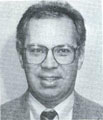|

|
Native Plantings On Illinois' Highways
By WILLIAM T. SUNLEY, Engineer of Local Roads and Streets
Credits to: Charles H. Gouveia, PLA Roadside Maintenance Manager
|
In pre-settlement times, nearly twenty-two million
acres of what was to be the State of Illinois were covered by native prairie and savanna vegetation. However, by 1950, less than one percent remained in scattered small parcels throughout the State.
During the 1950s the State of Illinois began construction of the Interstate Highway System which, when
completed 30 years later, would increase the size of
Illinois' roadsides to approximately 139,000 acres. As a
part of Interstate Highway construction, extensive
landscaping was done on the right-of-way. Typical of
highway landscaping styles of the time, the right-of-way was designed as a parkway setting with naturalistic
plantings and fully mowed expanses of turf. Native
trees and shrubs were included as part of the interstate
highway landscape to the extent that they were available. Native grasses, however, were not a part of the
highway planting programs through the 1960s when the
bulk of the interstate system in Illinois were constructed.
One of the early uses of native grasses for landscaping purposes was a landscape element, a seeded substitute for expensive shrub massing in an interchange. In
1969, a mixture of Little Bluestem, with scattered Pin
Oak trees, was seeded in the south interchange of 1-57
and 64 near Mt. Vernon. At that time, little information
was available on mass planting techniques for native
grasses, and sources of seed were limited.
In 1974, the Department of Transportation's Peoria
District used a tree spade to transplant some salvaged
native prairie to the Mackinaw Dells Rest Area on 1-74
near Goodfield in Woodford County. As a part of that
project, department staff also planted some native
grass and wildflower seed, hand collected from a
prairie remnant on highway right-of-way. Also in 1974,
they cooperated with a local Peoria group on a wild-flower seeding project using purchased seed that
foreshadowed Operation Wildflower efforts, discussed
later in this article.
In the Chicago area, experimentation was being
done by the Schaumburg District office in cooperation
with Iverson's Perennial Gardens on planting of wildflower plants and flower bulbs with a seedling tree
planter. This was developed as a technique to more
rapidly establish flowering herbaceous plants on highway projects.
Another means for the establishment of native vegetation on the highway right-of-way is Operation Wildflower. This program is conducted in cooperation with
the Garden Clubs of Illinois, Inc., and their local affiliate garden clubs. Operation Wildflower consists of a
cooperative effort between the clubs and the Department to establish flowering plants on the right-of-way.
Usually, the local Garden Club supplies or purchases
the plant material and the Department arranges its
planting at an agreed upon roadside location. In some
cases, the local Garden Clubs help with the planting, or
agree to provide post planting care to the plants.
The Department also has begun utilizing native
plants on a variety of restoration projects dealing with
vegetation types other than prairie or woodlands. The
most common of these projects involve wetland mitigation installations that utilize aquatic plants and seeding
mixes for wet or partially wet areas. The Department
has constructed a few projects that involve restoration
Page 24 / Illinois Municipal Review / June 1995
or establishment of woodland or savanna communities
with native plants typical to each. Supply of plant material for these specialized plantings is limited at present.
however, the contractors doing this work for the Department have thus far been able to locate commercial
sources to supply the majority of the required plants.
The newest native grass and wildflower establishment program is Corridors for Tomorrow, initiated in
1993. This program is funded through the Department's
portion of the Federal Intermodal Surface Transportation Efficiency Act as an enhancement project. The
goal is to establish wildflower and grass plantings at
interchanges, rest areas and State entrances where sufficient room exists, and other reconstruction is not
scheduled. In this program, landscape contractors handle planting and obtain their materials from commercial suppliers. The specifications for planting methods
and varieties are prepared by the Department's nine
District Landscape Architects, and vary according to
the area of the State in which they are planted. Hydro-seeding and drilling have been employed in both bare
ground seeding and in interseeding of existing turf
areas. In some projects, both seeding and plant plugs
are utilized in order to obtain faster establishment of the
permanent species, and annual flowering plants are
usually included to provide some color the first season.
New signs with color graphics depicting wildflowers,
prairie plants, wetlands or seedling trees, have been
developed to assist the traveling public in recognizing
the planted areas. •
June 1995 / Illinois Municipal Review / Page 25
|